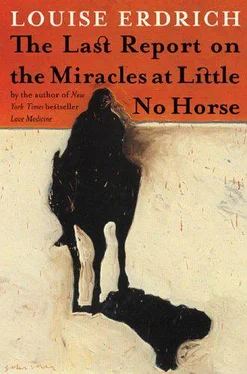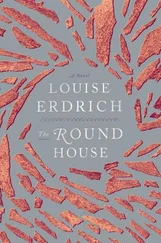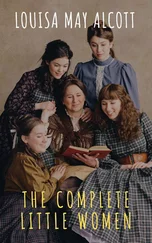Nimiigwetchiweyndan gikinoamadayininiwag gaye ikwewag, Tobassonakwut (Peter Kinew), Nawigiizis (Jim Clark), Pagawetakamigok (Lorraine Jones), and Paybomibiness (Dennis Jones). All mistakes are mine.
Louise Erdrich was born in 1954, the oldest of seven children, and grew up in Wahpeton, North Dakota, where her Ojibwa-French mother and German-American father taught at a Bureau of Indian Affairs School. She did not leave the region until 1972, when she entered Dartmouth College in Hanover, New Hampshire.
During and after college, Erdrich held a variety of jobs: She hoed sugar beets in Wahpeton; waitressed in Boston, Syracuse and elsewhere; worked in a state mental hospital in Vermont; taught poetry in prisons and schools in North Dakota; worked on a construction site; and edited The Circle , a Boston Indian Council newspaper.
Jacklight , Erdrich’s first book of poems, was published in 1983, followed a year later by Love Medicine , which won the National Book Critics Circle Award, the Los Angeles Times Award , the Janet Kaufman Award from the American Institute of Arts and Letters, and other prizes. Love Medicine eventually became the first novel in a remarkable series that would include The Beet Queen (1986), Tracks (1988), The Bingo Palace (1994), Tales of Burning Love (1996) and The Antelope Wife (1998).
In addition to these novels, Erdrich’s publications include a collaborative novel, The Crown of Columbus (1991, written with Michael Dorris), and another book of poetry Baptism of Desire (1989). She has written of art, infancy, and the natural world in her first work of nonfiction, The Blue Jay’s Dance (1995).
Louise Erdrich lives in Minnesota with her daughters. Her latest novel is The Last Report on the Miracles at Little No Horse.
Beginning with her National Book Critics Circle Award-winning first novel Love Medicine , Louise Erdrich has spent nearly two decades carving her own fictional landscape from both the rough and mystical details of life on and around a North Dakota Indian reservation. In her masterful new novel, The Last Report on the Miracles at Little No Horse , Erdrich weaves a tale that spans nearly a century, the strange and compelling story of Father Damien Modeste, a beloved reservation priest who has hidden his true identity as a woman beneath his cassock.
When the novel begins in 1996, movement is afoot to consider Sister Leopolda, the former Pauline Puyat, for canonization because of purported miracles associated with her. But Damien knows many dark truths about the deceased nun; truths learned in the confessional and pieced together from fragments of history and conjecture. The old priest writes to the Pope, the last of a lifetime of letters he has written to the Pontiff, to reveal the truth about the controversial Sister Leopolda.
Damien has remained silent about the Puyat woman for decades, not only because of the sanctity of the confessional, but also because she knew his own secret. He reflects back on his extraordinary life, unfolding the details of how Agnes DeWitt, a nun with an almost erotic obsession with the piano music of Chopin, is transformed into Father Damien.
After a quixotic journey, marked by armed robbers and a terrible flood, Agnes assumes the identity of the real Father Damien, lost in the flood, and spends the next 84 years on the reservation as an integral part of the community.
With his own brand of religion, Father Damien melds the rigid dogma of Catholicism with the ancient mystical beliefs of the Obijwe. He becomes a great friend of the elder Nanapush, and his life intertwines with those of the Kashpaws, Lamartines, Lazarres, Morrisseys, Pillagers — characters who inhabit all of Erdrich’s novels with Faulknerian deftness. Damien witnesses cataclysmic events that change reservation life forever — the devastating 1919 influenza epidemic, the white man’s land grab, and finally the coming of the Bingo Palace — as well as the private passions, devotions and crimes of the Obijwe people he grows to love.
Later in his life, the Vatican sends a priest to investigate the holiness of Sister Leopolda. Father Jude encounters a maddening evasiveness from Father Damien about the would-be saint. As he stumbles through his own misguided search for meaning and transcendence, he too will be singularly changed by what he encounters.
A passionate and poetic writer, Louise Erdrich lends both elegance and wit to her most ambitious novel to date. The Last Report on the Miracles at Little No Horse reaffirms Erdrich’s status as one of America’s best novelists.
A Conversation with Louise Erdrich
Your latest novel The Last Report on the Miracles at Little No Horse is the story of Father Damien Modeste and it spans from 1912 to the present.
1911 or 1912, yes. It then moves forward to nearly the present. But it also includes some history of characters and those histories occur before the turn of the last century. It spans the emotional and historical landscape of my previous books as well and, I hope, brings them into some sort of focus or sheds new light on some of the characters’s secrets. And of course it brings one character, Father Damien, who was a minor contributor to the book Tracks , into his/her own.
Everything in the novel — from people to places to the very landscapes — seems to exist between two extremes. Damien is Agnes. Leopolda is somewhere between sainthood and acts of cavalier cruelty. Even the bank robber is called The Actor. There is almost a Manichaean split between things. And rather than being an expose on hypocrisy, it’s more that these are the necessary tools of survival in a way.
I don’t interpret what I write so it’s interesting to hear it put in a way that makes it seem planned and intelligent. I write so much on instinct that I’m enthralled when I hear the word Manichaean to describe what my characters just do. Agnes becomes a priest through an act of revelation. She doesn’t become a priest out of calculation. For her it’s a revolution of the spirit. It is meant to be. For her, everything that has happened to her up to that point has drawn her toward the moment in which she makes the decision to go into the priesthood. She’s carried by the flood of her being into this priest’s garments. From then on, she makes the choice every day. She grows in a spiritual way — but she also inhabits almost another body and it becomes natural to her. By the end, she doesn’t think of herself as anything else in the outside world but a priest and yet within herself, continues to exist in her own persona. And there is always that question: are the personae that we deliver to the world intrinsic to us or have we assumed them the way The Actor assumes his roles in the first chapter of the book?
There is almost no difference in the book between the sacred and the profane. You know Agnes, before she’s even Agnes, while she’s a young novitiate. And she plays the piano. And she’s transported by Chopin whom you describe, I must say at one point, as a “pierogi snarfer,” which I think is a first for a description of Chopin.
Yes, but that’s much later and the devil is describing him in that way. In the beginning, Chopin is her angelic lover. She is physically initiated by the marvel of the emotion that he has hidden in his music for her to discover. Later, she loses her musical ability and forgets why her hands move. Then it comes back to her. Chopin’s music returns to her with all the solace of an internal caretaker and a lover. Which I think music is for many of us. It is something that we can return to again and again throughout our lives and it never ceases to comfort.
Читать дальше












